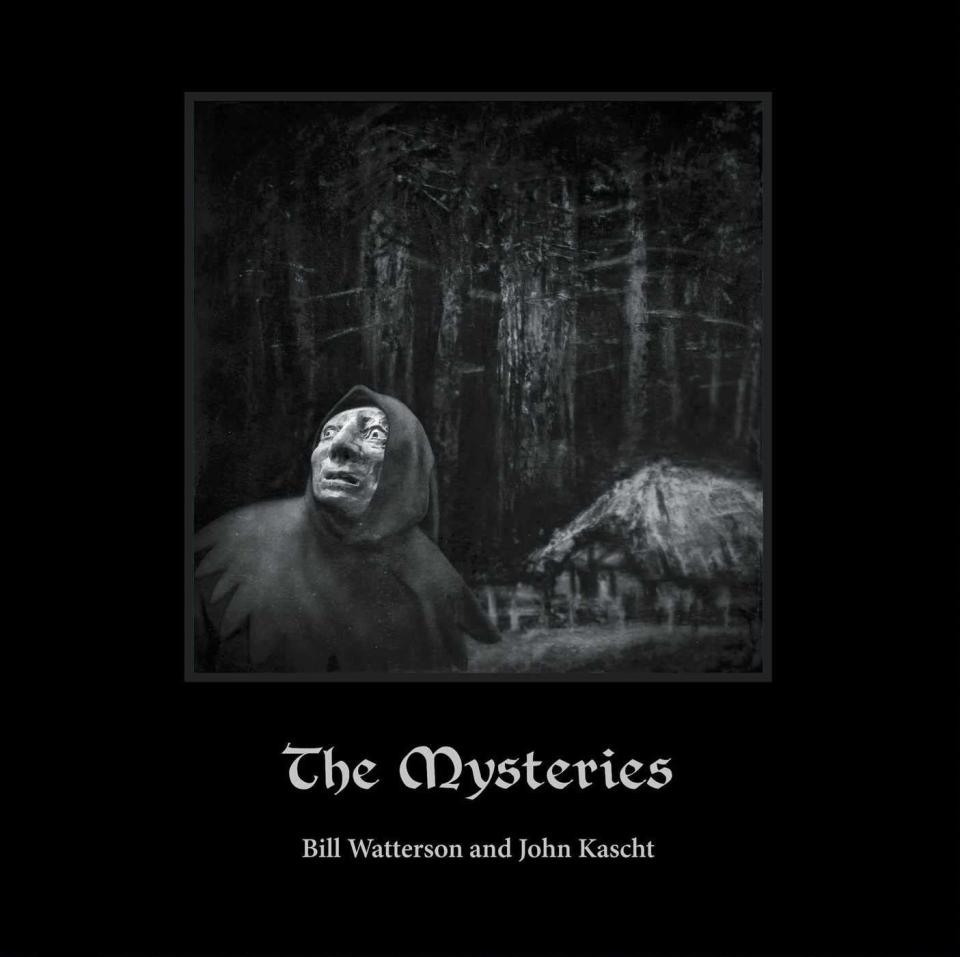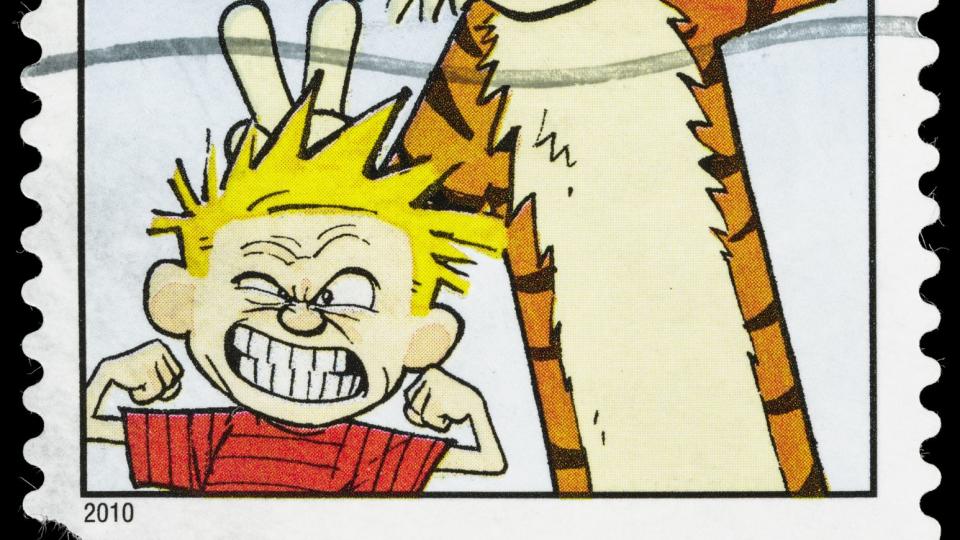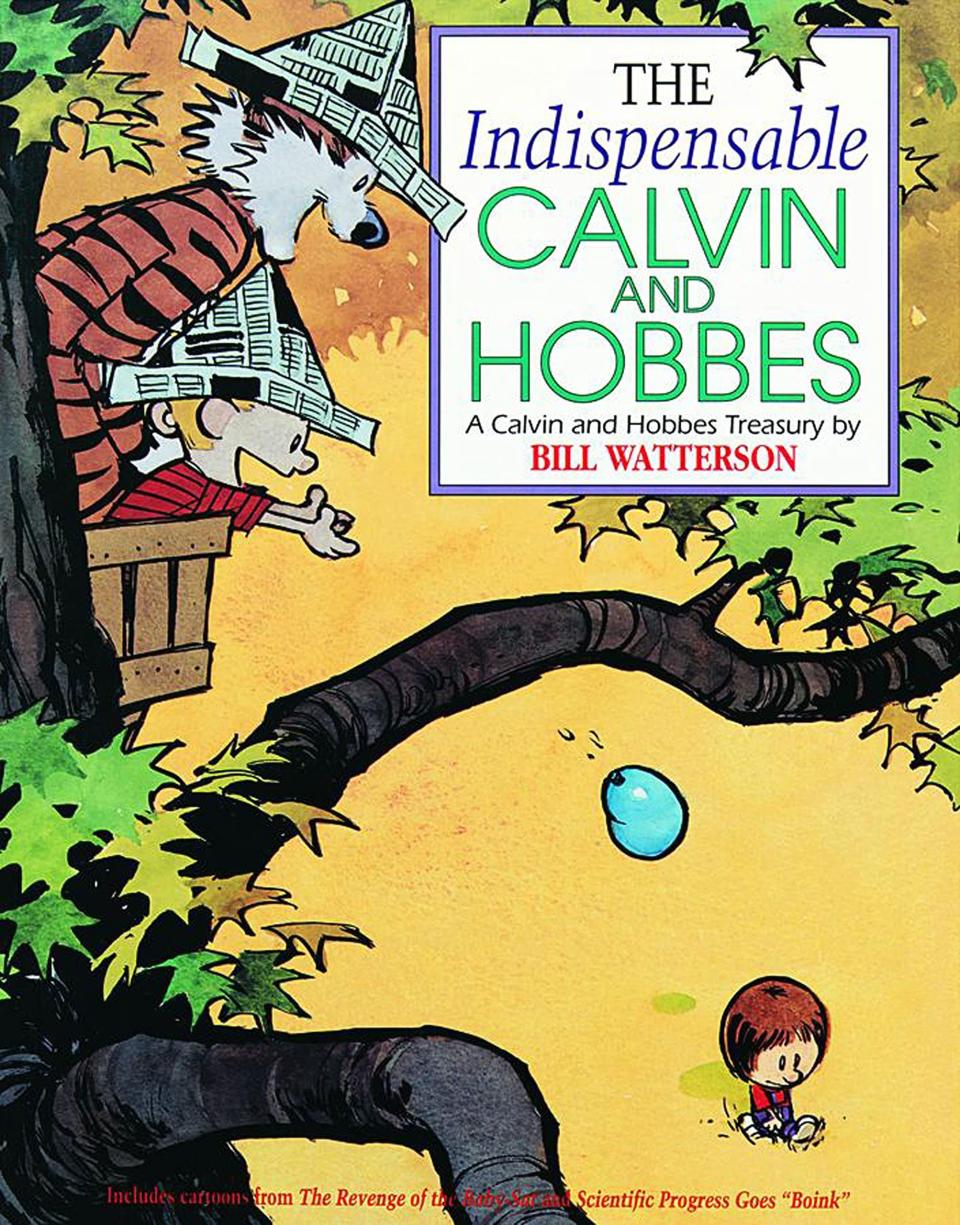Bill Watterson Released His First New Book Since ‘Calvin and Hobbes’
- Oops!Something went wrong.Please try again later.
- Oops!Something went wrong.Please try again later.

"Hearst Magazines and Yahoo may earn commission or revenue on some items through these links."
1958-present
Latest News: Bill Watterson Releases First Book in Years
Bill Watterson, 65, has a new book out. The Mysteries, released on October 10, is his first major book since Calvin and Hobbes. Written in partnership with caricaturist John Kascht, Watterson’s new work is described as a “fable for grown-ups” about “what lies beyond human understanding.” It tells the story of a long-ago kingdom afflicted with “unexplainable calamities,” prompting the king to dispatch his knights to investigate, only one of whom returns.

The Mysteries by Bill Watterson and John Kascht
amazon.com
$17.99
[table-of-contents] stripped
Who Is Bill Watterson?
Cartoonist Bill Watterson is best known as the creator of Calvin and Hobbes. While attending Kenyon College, Watterson drew political cartoons for the college paper, leading to a short-lived position at the Cincinnati Post. He worked odd jobs while developing Calvin and Hobbes, a cartoon about a rambunctious boy and his imaginary toy tiger friend, which was syndicated in 1985. The beloved comic strip ended a decade later. A famous recluse, Watterson has mostly stayed out of the spotlight since then. He released a new book, The Mysteries, in October 2023.
Quick Facts
FULL NAME: William Boyd Watterson II
BORN: July 5, 1958
BIRTHPLACE: Washington, D.C.
SPOUSE: Melissa Richmond (1983-present)
CHILDREN: Violet
ASTROLOGICAL SIGN: Cancer
Childhood and Education
Bill Watterson was born William Boyd Watterson II on July 5, 1958, in Washington, D.C. When he was 6 years old, Watterson moved with his parents—his mother, Kathryn, and his father, Jim, a patent attorney—to Chagrin Falls, Ohio. After the family settled in, Kathryn soon won a seat on the village council. James also served on the Chagrin Falls Village Council but not until some 30 years later.
As a child, Watterson—unlike his creation Calvin—“never had imaginary animal friends,” he later remembered. “I generally stayed out of trouble, I did fairly well in school.” He developed an early interest in drawing and was inspired by classic cartoonists like Peanuts creator Charles Schulz, Krazy Kat cartoonist George Herriman, and Pogo illustrator Walt Kelly. Often spending time alone and drawing, he created his first cartoon at age 8.
In 1976, Watterson enrolled at Ohio’s Kenyon College, where he spent four years drawing political cartoons for The Keyon Collegian campus newspaper. One of his college strips featured “Spaceman Spiff,” a parody of Buck Rogers, and one of Calvin’s future alter egos in Calvin and Hobbes. His drawing talents weren’t limited to the newspaper. During his sophomore year, he painted a copy of Michelangelo’s Creation of Adam on his dorm room ceiling.
Early Career
Following his 1980 college graduation, Watterson was immediately offered a job as an editorial cartoonist at the Cincinnati Post. His editors were initally unimpressed with his work, and less than a year later, Watterson found himself unemployed and living back home with his parents. He decided to abandon political cartoons (he was not particularly interested in politics, anyway) and return to his first love: comic strips.
The next few years proved mostly discouraging. Watterson sent his strips to countless newspapers and received nothing but rejection slips. For a time, he took an unhappy job designing advertisements for car dealerships and grocery stores.
This period in his life was important, he later said, because it proved to him that the substance of his work mattered more than money. “To endure five years of rejection to get a job requires either a faith in oneself that borders on delusion or a love of the work,” he told the 1990 graduates of his alma mater in a commencement speech. “I loved the work.”
Calvin and Hobbes

After experimenting with several different characters, Watterson developed a strip called Calvin and Hobbes. It starred Calvin, a rambunctious first-grader who sounded “like a 6-year-old psychotic on Ritalin one day and a Yale lit grad the next,” as one journalist put it, and Hobbes, a stuffed tiger who came to life only when alone with Calvin. Watterson named the main characters after theologian John Calvin and philosopher Thomas Hobbes.
Universal Press Syndicate bought the strip in 1985, giving Watterson, then just 27 years old, a national audience.Readers loved Calvin and Hobbes, including Calvin’s flights of wild imagination, often undertaken while clad in rocket-ship underpants; Hobbes’ wry observations; and the sensitive, wise, literary voice of the strip itself. In 1986, Watterson became the youngest cartoonist ever to receive the National Cartoonists Society’s Reuben Award—the industry’s highest honor.

The Indispensable Calvin and Hobbes: A Calvin and Hobbes Treasury by Bill Watterson
amazon.com
$11.89
With the strip’s popularity exploding, Universal Press Syndicate was eager to produce and sell Calvin and Hobbes merchandise. Watterson refused. Merchandising, he said, “would turn my characters into television hucksters and T-shirt sloganeers and deprive me of characters that actually expressed my own thoughts.” That’s why there are no official Calvin and Hobbes toys or t-shirts, though unauthorized reproductions of the characters still abound. “I clearly miscalculated how popular it would be to show Calvin urinating on a Ford logo,” Watterson once quipped, referring to the popular bootleg car window decals.
Watterson pushed for changes in the format of Sunday newspaper comic strips, feeling the typical layout was restrictive, and the habit of newspapers to cut out the top two panels when necessary to make room forced him to waste time with throwaway jokes in those panels that had little to do with the rest of the cartoon. Watterson successfully convinced some newspapers to adapt a new, larger format, which drew criticism from both the publications and other cartoonists who were forced to adapt to the change. Watterson also strongly advocated for the legitimacy of comic strips as an art form, rejecting the idea of “high art” and “low art,” and instead arguing they each had equal value.
After 10 years of writing delighting readers, Watterson announced in 1995, to the heartbreak of fans, that he was ending the strip, saying that he had done all he could with Calvin and Hobbes. The final cartoon ran on December 31, 1995. In it, Calvin and Hobbes excitedly bring their toboggan outside after a fresh night’s slow, and they sled away as Calvin says, “It’s a magical world, Hobbes, ol’ buddy. Let’s go exploring.”
Watterson has said he has no regrets about ending Calvin and Hobbes when he did. “It’s always better to leave the party early,” he said, via email, in a rare interview with The Plain Dealer in 2010. “If I had rolled along with the strip’s popularity and repeated myself for another five, 10 or 20 years, the people now ‘grieving’ for Calvin and Hobbes would be wishing me dead and cursing newspapers for running tedious, ancient strips like mine instead of acquiring fresher, livelier talent. And I’d be agreeing with them.”
All the Calvin and Hobbes comics have been published across dozens of books released since 1987, including The Complete Calvin and Hobbes, a collection of every comic strip, which was published in 2005.
Later Career: Cartooning for Charity and New Book
Watterson has remained largely out of the public eye since the Calvin and Hobbes, rejecting most interview requests and largely maintaining his privacy. However, he has contributed artwork or writings for various cause and publications over the decades. When his hero Charles Schulz died in 2000 at age 77, Watterson broke his post–Calvin and Hobbes public silence to pen a tribute to his hero for The Los Angeles Times, describing how Schulz disregarded “cinematic” visual styles in favor of simple but expressive artwork that “reveal a deep understanding of cartooning’s strengths.”
Watterson took up painting after the publication of Calvin and Hobbes, largely keeping those works private, spending time creating landscapes of Ohio woods with his father. He did participate in a public art exhibition in 2011 that featured an oil portrait of Petey Otterloop, an 8-year-old character from the comic strip Cul de Sac by Richard Thompson. Thompson, who had Parkinson’s disease, established an art exhibit and auction in support of the Team Cul de Sac charity for Parkinson’s research, and Watterson was one of more than 100 cartoonists who contributed original art for the cause.
Watterson provided what he called “a few sentences” of voiceover remarks for Stripped (2014), cartoonist Dave Kellett’s documentary about comic strips. He also illustrated the poster for the film, which featured a cartoonist who literally leaps out of his clothes in surprise while reading about the demise of newspapers. Watterson said: “Given the movie’s title and the fact that there are few things funnier than human nudity, the idea popped into my head largely intact.”
Also in 2014, in another effort to raise money to fight Parkinson’s disease, Watterson secretly collaborated with cartoonist Stephan Pastis on three strips of Pastis’ comic Pearls Before Swine. In the strips, a second-grader schools Pastis on how to properly draw. It was Watterson’s idea to be Pastis’ secret guest cartoonist, and his involvement wasn’t publicly revealed until after the strips were published that June. After having read a previous Pearl Before Swine cartoon that referenced Calvin and Hobbes, Watterson said, “I thought it might be funny for me to ghost Pearls sometime, just to flip it all on its head.” The money they raised supported Team Cul de Sac and the Michael J. Fox foundation.
Watterson released his first major book, entitled The Mysteries, since Calvin and Hobbes in October 2023. Written in partnership with caricaturist John Kascht, Watterson’s new work is described as a “fable for grown-ups” about “what lies beyond human understanding.” It tells the story of a long-ago kingdom afflicted with “unexplainable calamities,” prompting the king to dispatch his knights to investigate, only one of whom returns.
Personal Life
Watterson and his wife, Melissa, live in Cleveland, where he keeps a low profile and declines most interview requests. The Washington Post described him as “the J.D. Salinger of the strips,” and he was included on Time’s list of the most reclusive celebrities. “He would like it all to fade away,” Watterson’s father, Jim, told the Cleveland Plain Dealer in 1998. “He doesn’t get his kicks by being famous. He was just doing something he enjoyed doing.”
Watterson and his wife have a daughter named Violet.
Quotes
To endure five years of rejection to get a job requires either a faith in oneself that borders on delusion or a love of the work. I loved the work.
It’s always better to leave the party early.
A real job is a job you hate.
It’s surprising how hard we’ll work when the work is done just for ourselves.
Fact Check: We strive for accuracy and fairness. If you see something that doesn’t look right, contact us!
You Might Also Like

